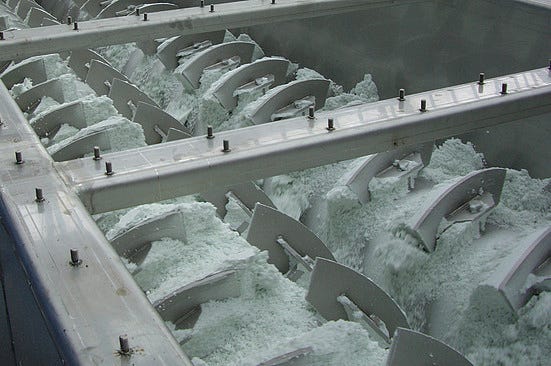Efficient Drying of Fiberglass
February 8, 2011
By Cynthia Meijer, Celsius
|
An alternate angle of the Lanxess Machine |
Celsius has designed a dryer for drying finely chopped fiberglass, or chopped strands, for Lanxess, one of the world’s leading suppliers of engineering plastics. A plate dryer was previously used, but this method was relatively expensive because of its inefficiency. With no more than the drying requirements, the bridging of the height difference and the capacity, after extensive testing, the supplier Celsius designed a screw heat exchanger with a process guarantee for Lanxess.
At the plant in Kallo, Belgium, Lanxess produces fiberglass and rubber chemicals. The fiberglass is used as a raw material for high-tech plastics. The minuscule fiberglass chopped strands reinforce the plastic. Technical components are made from these plastics that meet the highest specifications in the area of loading capacity, functional reliability, and durability. Such components are used, for example, in the automobile industry, electronics industry, and in household appliances.
In spite of the hot production process, the chopped strands still contain some 10% moisture and the content in the end product may be a maximum of 0.1%. For the past 20 years Lanxess has been using a steam-heated plate dryer for this. In addition to the necessary drying properties, required end product quality and capacity, it was important that this new installation could also bridge a height difference. At the outlet from the installation the product has to be able to fall into a filter installation before being collected in a storage tank. The product may also not be crushed in the installation. Celsius designed a dual-shaft screw heat exchanger for this.
The most important process parameters for the installations are the temperature of the thermal oil for the indirect evaporation process and the residence times in the installation. The 185°C oil flows through the screws and the trough of the screw heat exchanger. A heating installation, located directly alongside the heat exchanger, brings the oil up to temperature using natural gas. The Celsius screw heat exchanger is about 9 meters long, including the drive, and about 2 meters high at the highest point. It is some 2 meters wide and the heat exchanging surface is approximately 20, 30, or 40 square meters. The installation is easy to control because the temperature is constant, as is the flow rate or capacity. There is just a frequency regulator on the motor.
|
Lanxess machine during a Factory Acceptance test |
Screw Heat Exchanger
The screw heat exchanger is an indirect heat exchanger. The product is moved by a screw conveyor. A double wall separates the product from the heating or cooling medium. Various thermal fluids are suitable for the supply or removal of energy. For cooling these may be water, iced water, or glycol, and for heating, water, thermal oil, or steam can be used. The heat transfer takes place via the trough wall, screw shaft, screw blades, or a combination of these. This is not only a low-energy method but compared with air dryers also results in less dust formation. Various dimensions are possible, depending on the process requirements and space available. As construction material various types of stainless steel or other types of metal are used, geared to the hygiene and quality requirements. When used for drying processes there must be sufficient ventilation to remove the moisture. Indirect drying limits the quantity of ventilation air and makes air treatment equipment less necessary.
Lanxess
With more than 1400 employees and four factories, Belgium is the second most important production country for Lanxess in Europe. The group calls itself an important player in specialty chemicals and in 2008 achieved a turnover of 6580 million Euro. The total number of personnel is 14,800, spread over 44 production plants in 21 countries. The core business is the development, manufacture, and sale of plastics, rubbers, semi-finished products such as fiberglass, and chemical specialties, such as butyl rubber.
Cynthia Meijer can be reached at [email protected]. For more information on Celsius (the Netherlands), call +31(0)416 38 22 92 or visit www.celsius.nl.
You May Also Like




